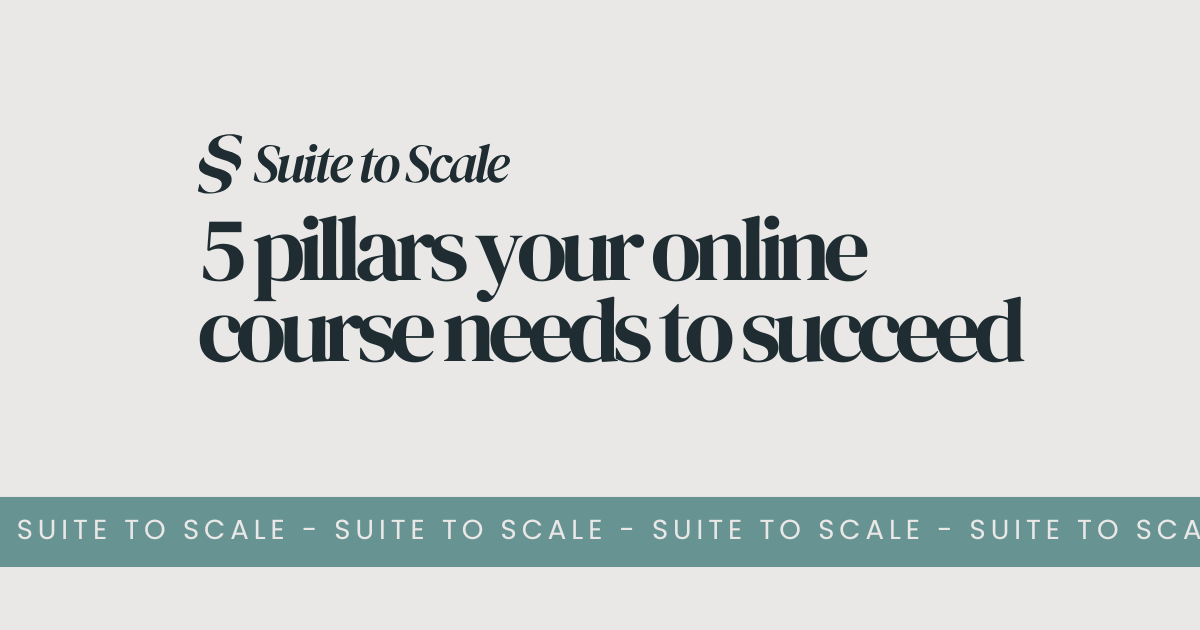- Suite to Scale
- Posts
- 🍭 Before you create that course...read this
🍭 Before you create that course...read this
A high-impact course starts with a clear foundation.

Hey, it’s Kat here 👋
Let’s talk about creating a successful online course.
If you’re a service provider moving into digital products, this moment is exciting and also incredibly overwhelming.
You’ve probably got dozens of course ideas.
A pile of notes.
Some slides started.
Maybe even a partially built outline or two.
But you’re stuck.
And if you’ve already launched a course that didn’t sell? You might be wondering what went wrong and whether you should even try again.
A great course is not just about how much you know.
It’s about how clearly you can take someone from problem to transformation, and how intentionally you structure everything around that.
So let’s break it down into something simple and clear: the 5 Pillars of a Successful Online Course.
👀 ICYMI
🍭 The 5 Pillars of a Successful Online Course
These are the things I walk through with every client, whether they’ve already built something or they’re starting from scratch.
Let’s get into it:
Pillar 1: A Clear Transformation
What’s the before and after your course delivers?
A successful course doesn’t just teach content.
It helps your student achieve something specific.
You want to be able to clearly say: “By the end of this course, my student will go from [current struggle] to [specific result].”
If this is fuzzy, the rest of your course will be too (and your marketing for that matter).
Because the content, format, and sales message all depend on this transformation.
This is where most courses fall flat.
They try to include everything. But when you teach everything, the transformation gets buried.
When the transformation is buried your customers don’t know exactly what they’re getting out of this program.
What will your student be able to do, understand, or implement by the end of your course?
The best courses promise (and deliver) a specific transformation.
If it’s vague, they won’t buy.
If it’s too broad, they won’t finish.
Your job is to define the before and after of your course.
Start here. Get crystal clear on the result.
Then reverse-engineer your marketing content and sales plan around that.
Pillar 2: Course Validation & Market Fit
Before you build, test the idea.
You don’t need 10,000 followers to validate a course idea.
You just need to know that the right people want the result you’re teaching and that they’ll pay for it.
There are different ways to validate your course idea.
If you’ve got a large engaged audience (that is your ideal customer) then you may choose to do interviews, send out surveys, and find out how many people have bought courses related to this topic in your audience.
One of the best ways to validate?
Pre-sell your course. 😱
I know it feels scary but it’s a great way to validate that your audience wants what you have to offer. They’ve literally paid for it.
Pick a launch date 4–6 weeks out. Sell it now. Build it after you’ve made sales.
You’ll learn so much from running a presale:
Who’s interested
What messaging resonates
Where the objections are
You’ll also stop second-guessing every module because you’ll know real people are waiting for it.
Validation comes in many forms.
I’ve done interviews, surveys, pre-sales, and more.
The best results came from pre-sales, 1:1 interviews, and having audience members that previously reached out to me asking if I had a solution to a specific problem my new course was solving.
You don’t want to create a whole course only to find out that your audience doesn’t need it. Been there, done that, 0/10 I do not recommend it!
Pillar 3: Strategic Content Map
Once you’ve got validation and a clear transformation, then you build.
This is where we map the journey.
Your content map is the flow of lessons, modules, and action steps that guide your student from Point A to Point B.
But you don’t need 30 lessons. You need the right lessons in the right order.
Here are some things to consider:
What must they know or do first?
What can you remove that’s not essential?
How can you create momentum early on?
What needs a deep dive vs. just a template?
Your map should help them feel progress quickly.
Because nothing motivates a student to continue like small wins.
This is something I wish I did earlier in my course creation journey. The programs that had early wins in Chapter 1, led to higher completion rates and better outcomes.
I always recommend building your course outline like you would a 1:1 project. With your client work you know the best path to follow to achieve a specific result.
This is the same thing. The only difference is you might add in some small wins initially and some surprises at certain milestones to delight the students.
This is where your experience as a service provider becomes a huge asset. You know what actually helps people get results. Now you just need to package it into a teachable path based on how people learn and stay motivated to learn.
Pillar 4: Aligned Delivery Format (and Support)
Now that you know what you’re teaching, decide how you’ll teach it.
This is where your energy, strengths, and life outside the business matter.
There’s no one right way to deliver a course.
You might love live calls.
Or you might thrive when you batch content and go async.
You might enjoy detailed Loom videos or prefer a written-only approach.
Support options also come in many forms:
Live Q&As
Async chat support
Pre-submitted feedback
Group forums
A searchable FAQ doc
The key is to match the delivery and support style to:
What helps your students succeed and stay motivated
What you can sustainably deliver and would enjoy delivering
I’ve tested out office hours, live coaching calls, FAQ feedback forms, support via email, and more.
⟫ Create the kind of experience that works for you and gets results for them.
Pillar 5: Simple Systems
This is where the tech comes in and where a lot of creators overcomplicate things.
You don’t need 12 platforms and 6 workflows.
Here’s the core question: How will people find it, trust it, and buy it?
You need:
A simple sales page (did you know some creators have sold courses using a Google Doc as their sales page?)
A simple checkout process (This usually comes with your course platform host)
A delivery platform (course host platform or email automation)
A simple funnel that gets people from freebie or content to your course (I pre-sold my first course using FB lives and 3 emails to 121 people only. That was it.)
How many times can I say simple in one email? As many times as it takes to realize you can keep it simple and make sales.😀
You can build this gradually.
Start with a freebie, a welcome email, and a single email about your course.
Once that’s in place, you can add a nurture sequence, sales page optimization, automations, upsells, etc.
The best systems are the ones that you can actually run.
🎯 This Week’s Action:
Start with Pillar 1.
Whether you’ve launched a course before or you’re creating one now, come back to this question: What transformation does my course deliver?
Write out the before and after:
What’s your student struggling with before?
What are they able to do/understand/have after?
If your course isn’t selling or you don’t know what to build next, start here.
Clarity on this question will guide everything else.
Need help mapping your course from idea to income?
If you're swimming in too many ideas, or stuck deciding what to build first, book Your Next 90 session with me.
In 2 hours, we’ll create a 90-day plan that fits your goals, your energy, and your expertise.
You’ll walk away with:
→ Clarity on your course transformation
→ A simple launch path that fits your schedule
→ Confidence to actually move forward
Just reply to this email or book your session here.
You’ve got this.
🦄 In Your Corner
You don’t have to teach everything.
You just have to teach the thing you know best in a way your audience can follow.
Your lived experience, your frameworks, and your way of teaching already have value.
And right now, someone is out there searching for the exact solution that’s sitting in your notes folder.
Give yourself permission to start with one clear transformation.
The rest will follow.
This week’s edition is sponsored by: 1440 Media
I’ve signed up for their business and finance version of the newsletter.
It’s a mix of all things business/finance and it keeps me in the loop on changes in that space. I personally enjoy reading the editions that focus on the creator economy. Here’s more info about their general newsletter written by their team 👇
Daily News for Curious Minds
Be the smartest person in the room by reading 1440! Dive into 1440, where 4 million Americans find their daily, fact-based news fix. We navigate through 100+ sources to deliver a comprehensive roundup from every corner of the internet – politics, global events, business, and culture, all in a quick, 5-minute newsletter. It's completely free and devoid of bias or political influence, ensuring you get the facts straight. Subscribe to 1440 today.
🫡 KM Tip of the Week
Start simple and build smarter.
One of the biggest mistakes first-time course creators make?
Trying to build the final version of their course on day one.
You don’t need the full platform setup, a 7-part video series, and 12 emails written before you begin.
Start with what’s essential:
→ A clear transformation
→ A simple outline
→ A way to validate your idea
Then add layers as you go.
You’re building a product, not a performance.
And your first version is allowed to be a starting point, not the end result.
The course that changes lives isn’t always the one with the fanciest modules.
It’s the one that helps someone solve a real problem in a way they understand and can act on.
My own program The Pinterest Gameplan evolved every year that I launched it.
You don’t have to have the perfect final course from day one.
It’s better if you don’t because your students will guide you with what they need more or less of.
😂 Meme of the week
When you say, “it’s a quick task, it won’t take me that long”…

Thanks for reading this week’s edition.
Have a wonderful week!
- Kat Moorhouse 🍭
How did you like this week's email? |